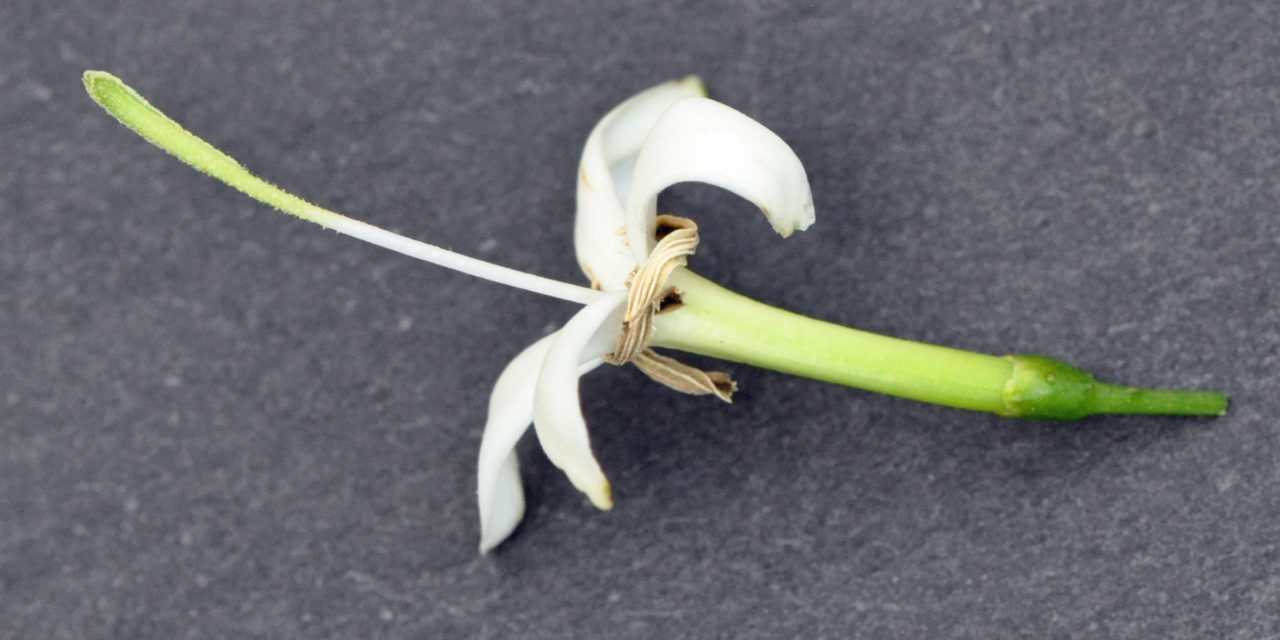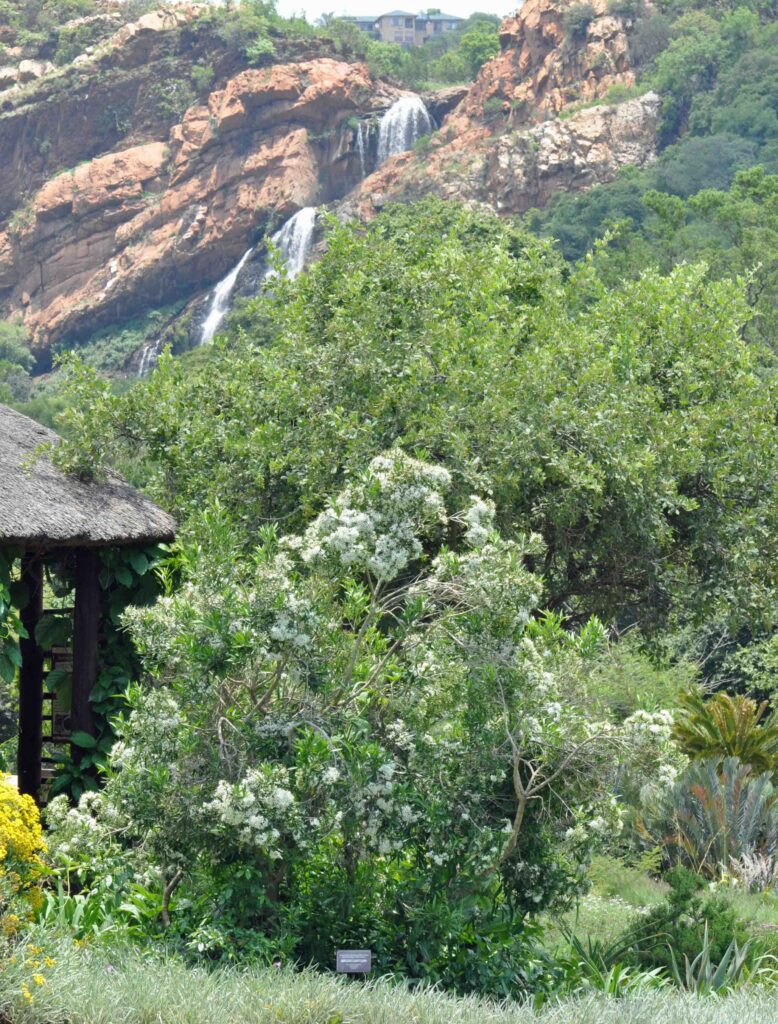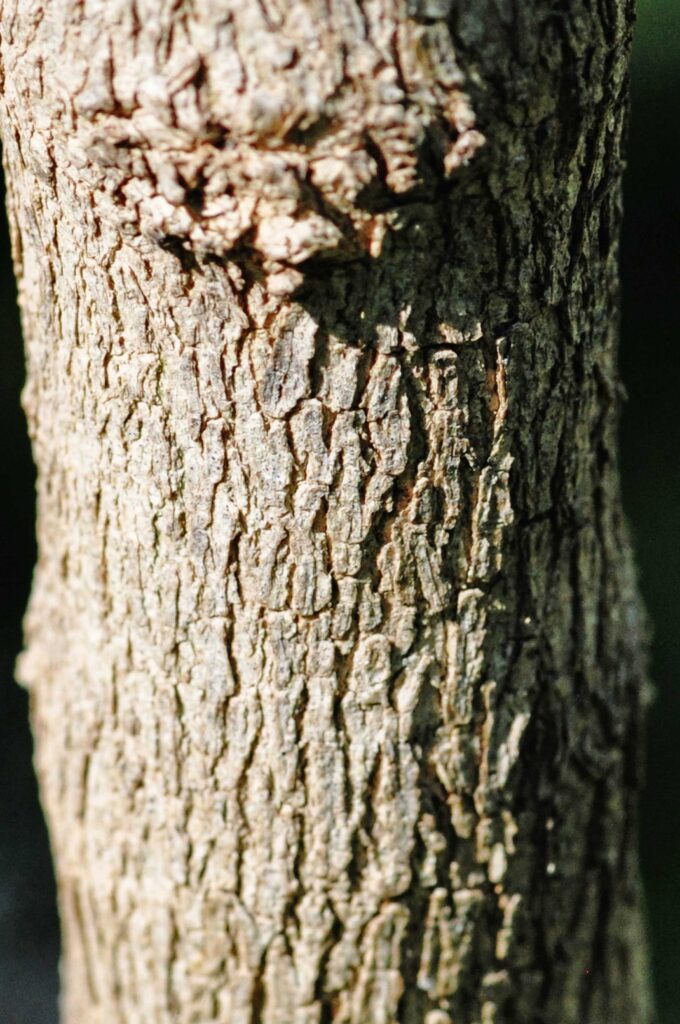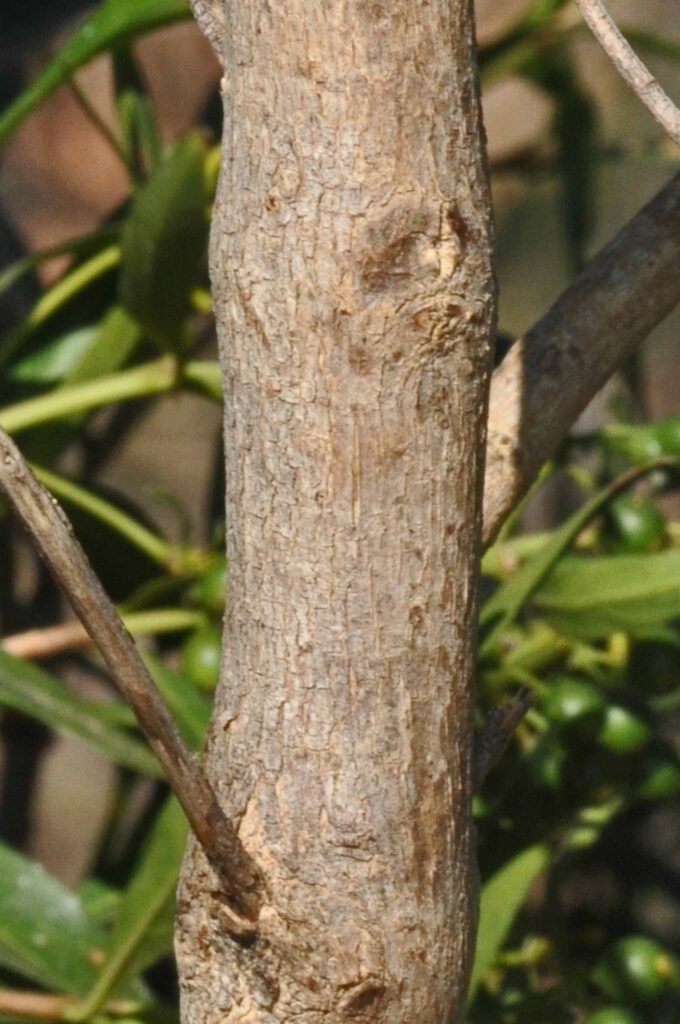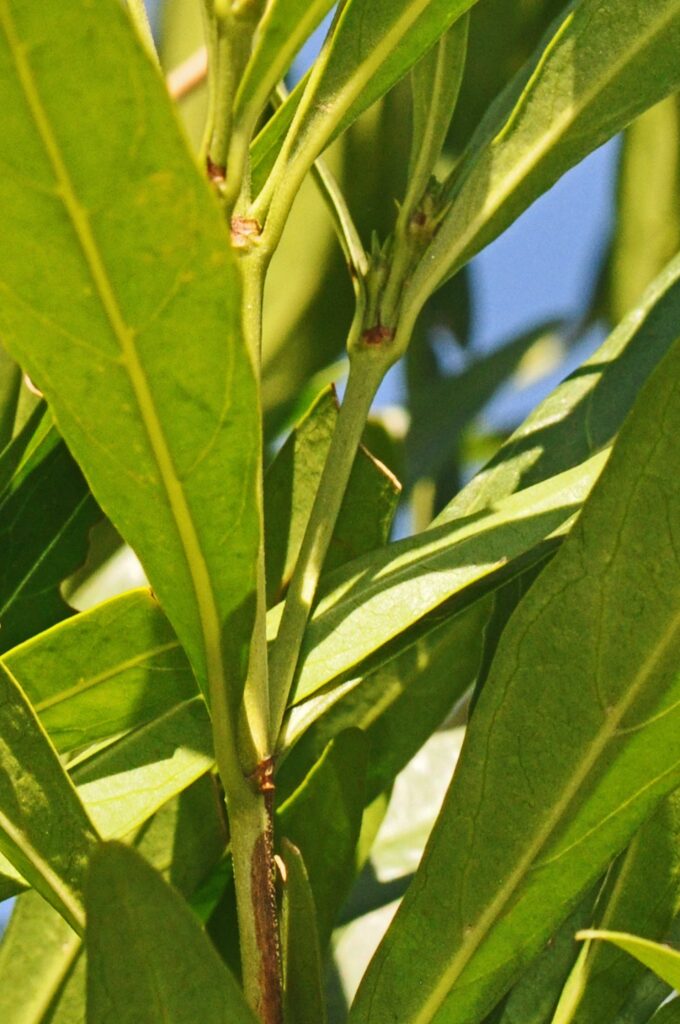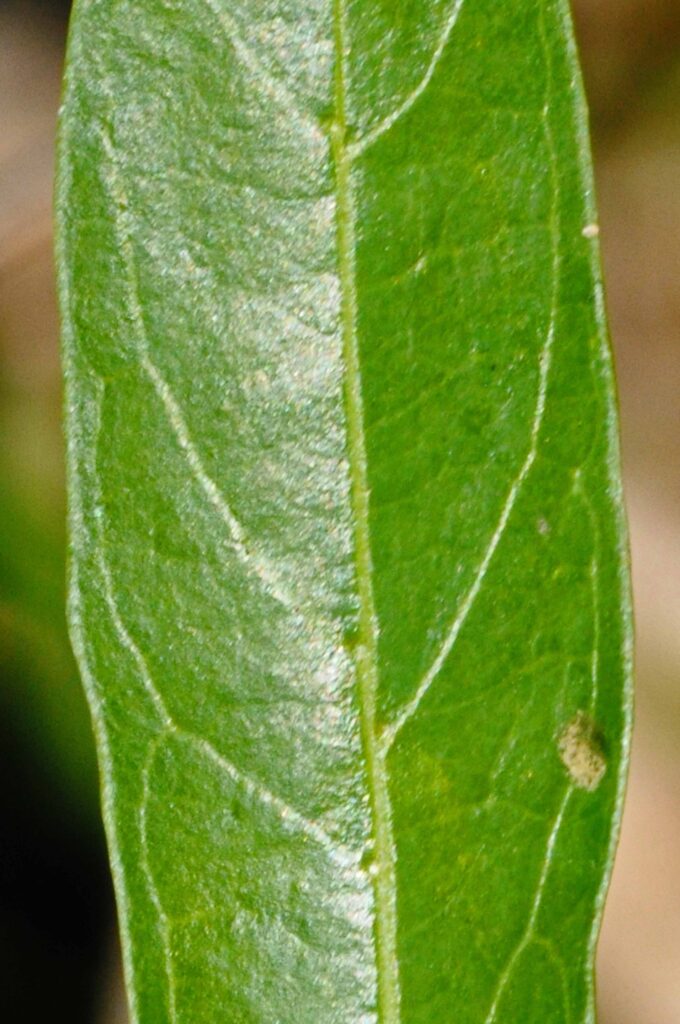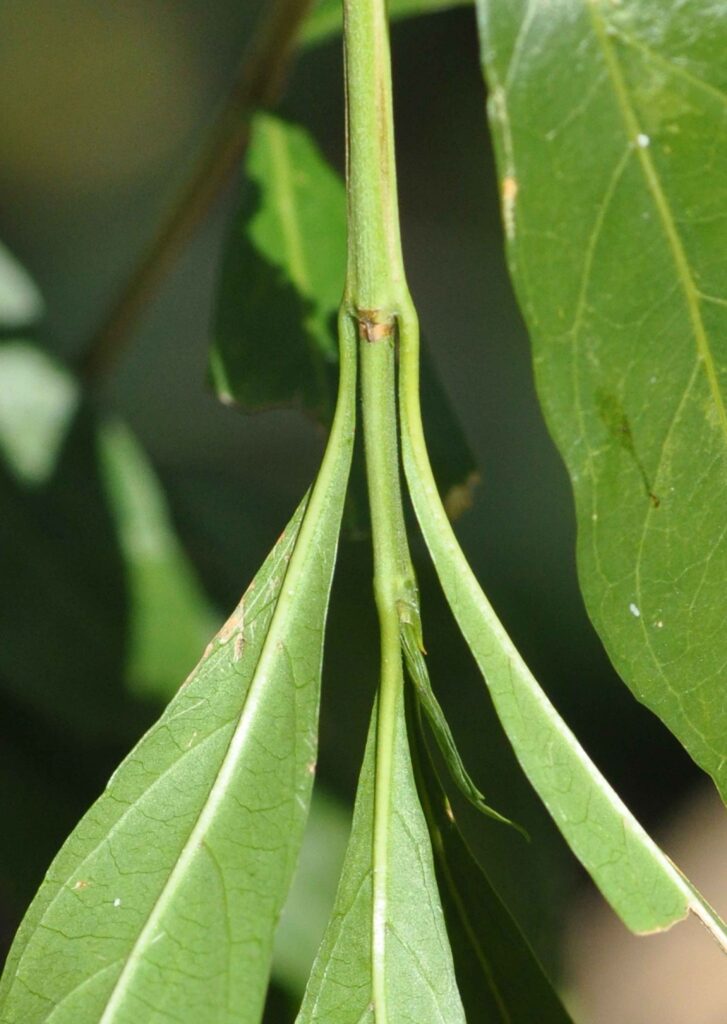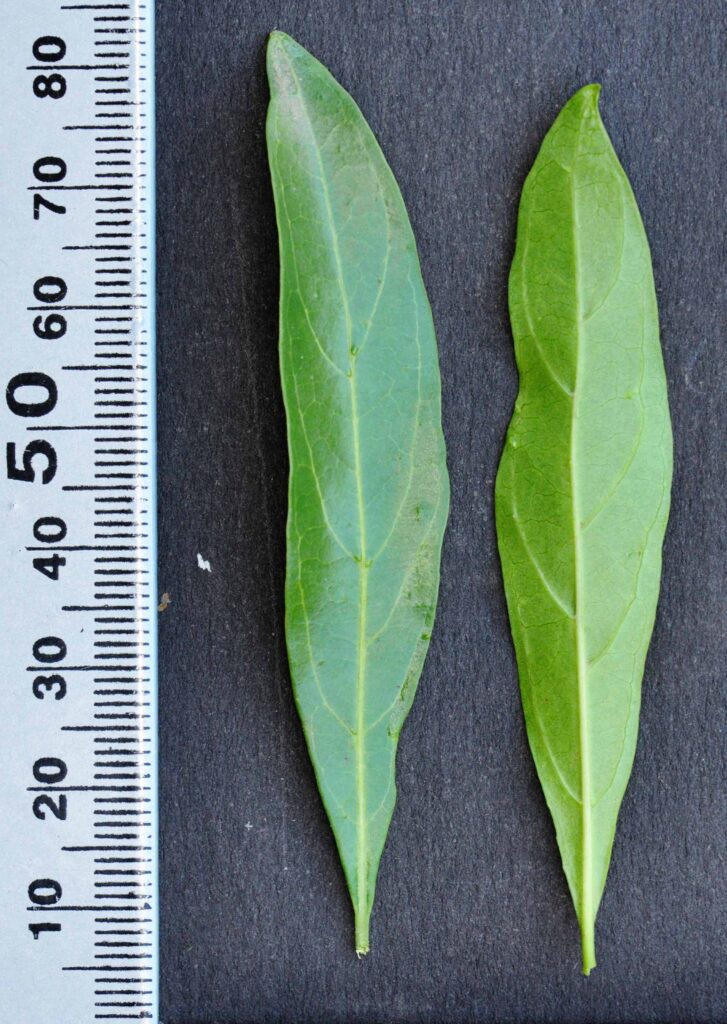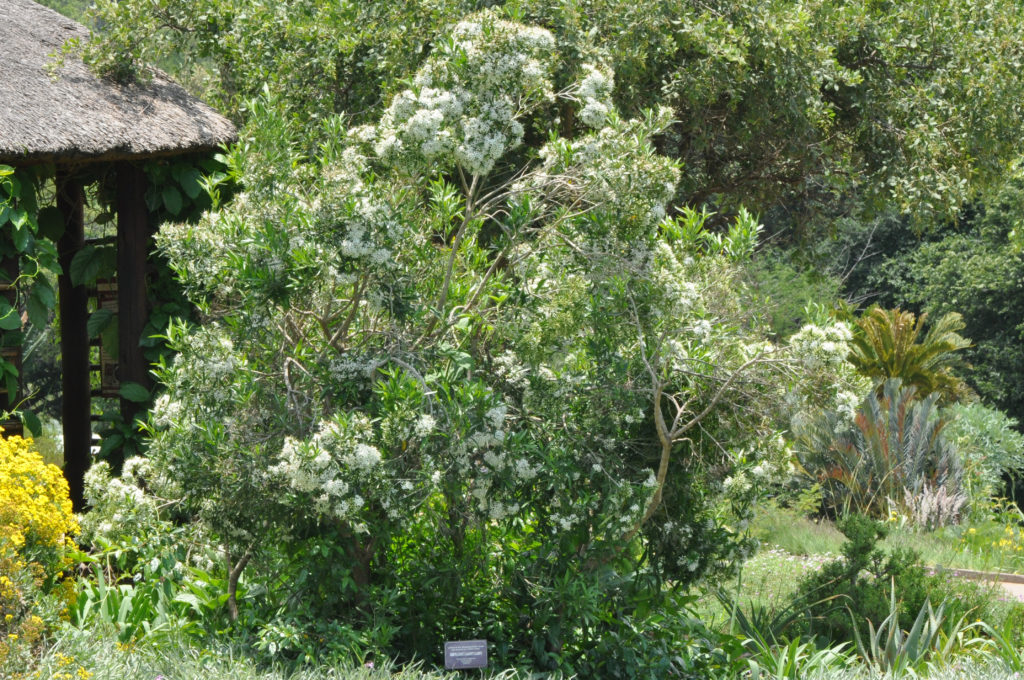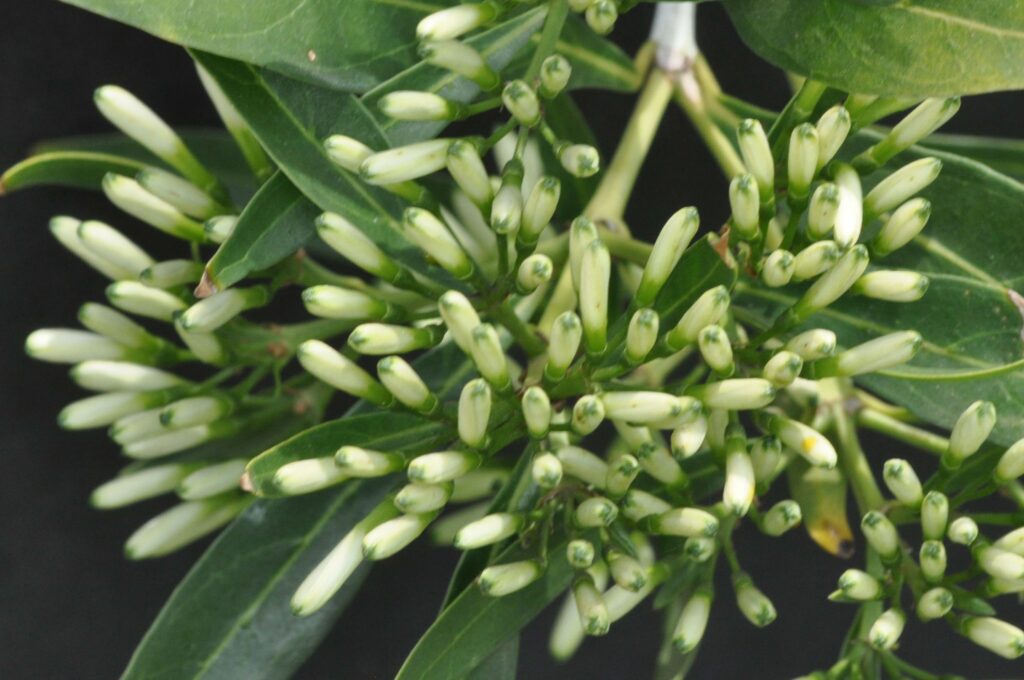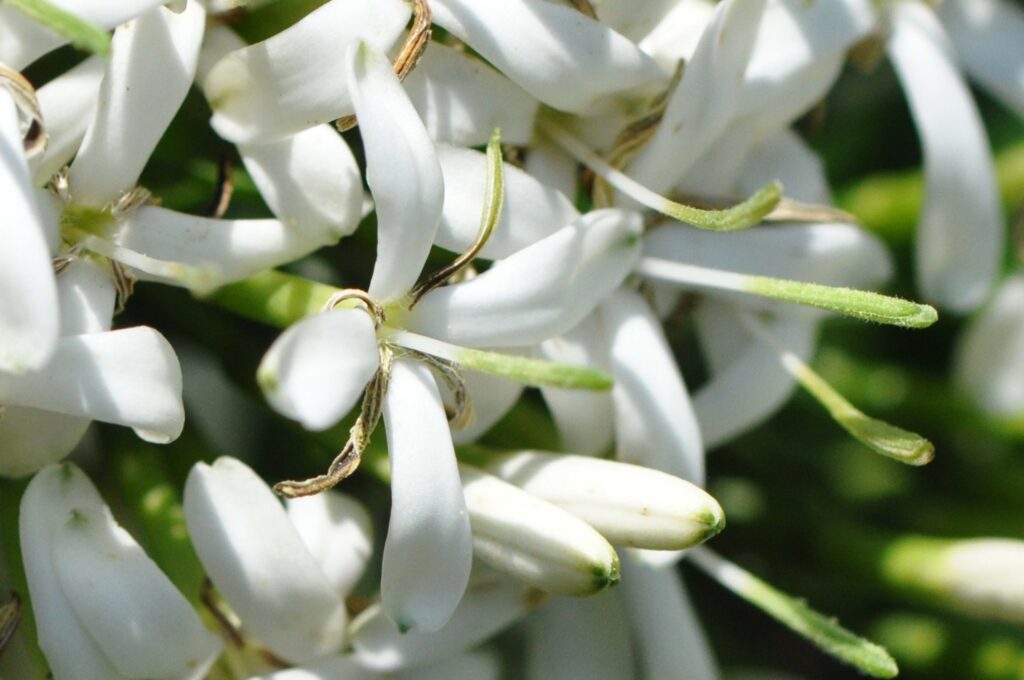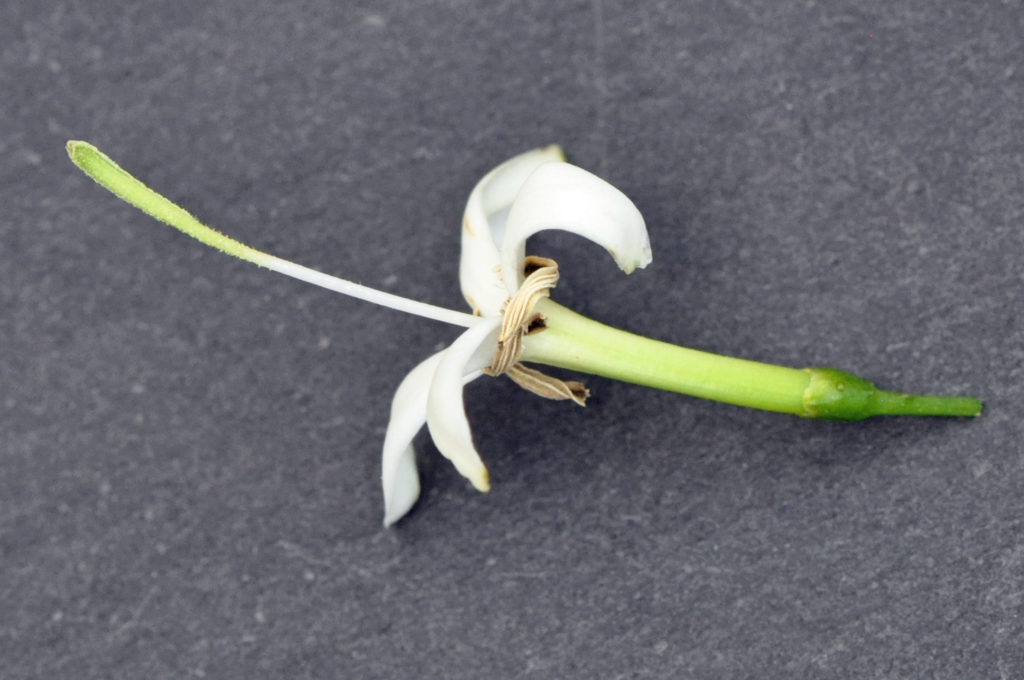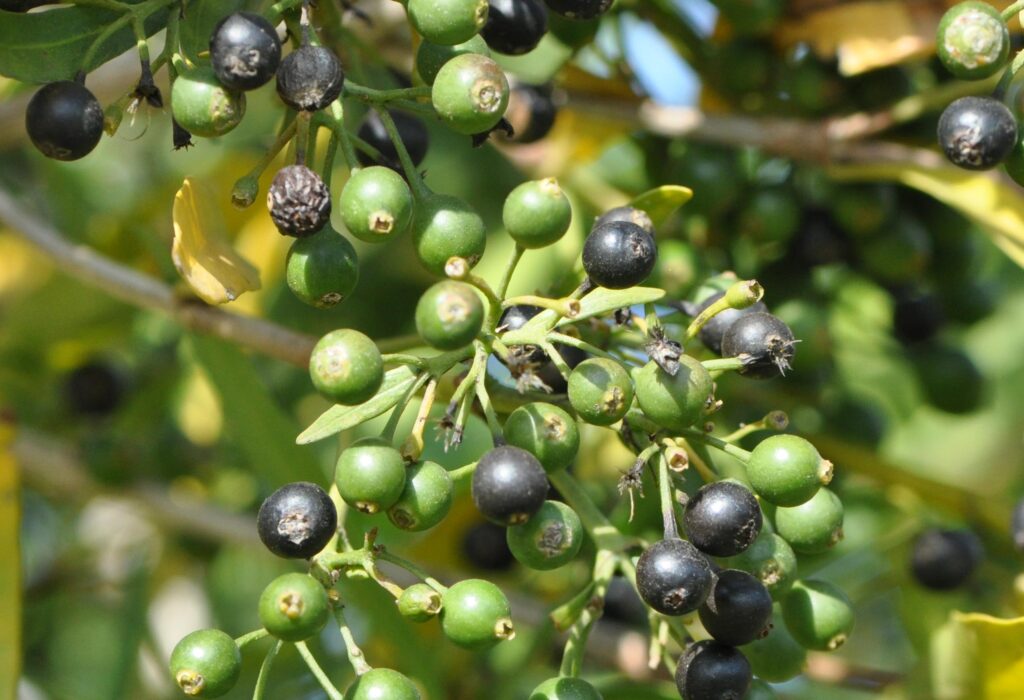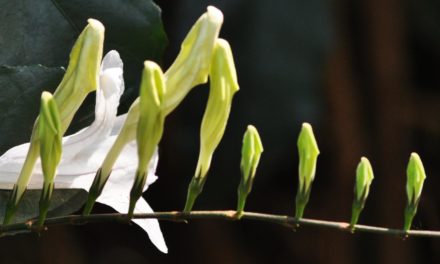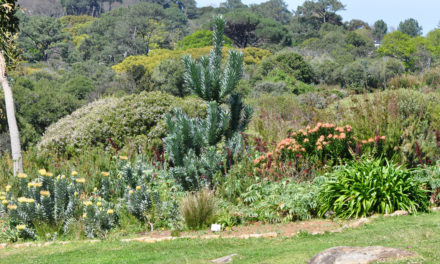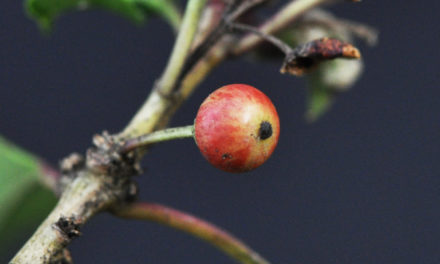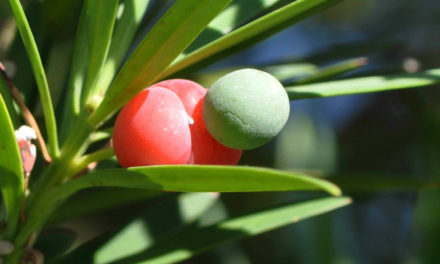General Info – summary
This evergreen plant is a shrub or a Tree up to 6m high with squarish young branches. Decussate, elliptic, edible Leaves are simple, entire and domatia may be present. Bisexual tubular white Flowers are regular and 4-merous. The corolla tube and the exserted style are long and distinctive. Linear anthers envelop the outer bases of the petal lobes. Pea-sized Fruit is usually a single seeded drupe that is black when mature.
Description
Pavetta lanceolata
Previous Names: Ixora lanceolate, Pavetta alexandrae, Pavetta inandensis, Pavetta opaca, Pavetta tristis.
SA Tree No. 718.1.
Common names: (Afr) Kermisboom, Treurbruidsbos. (Eng) Christmas Bush, Christmas Tree, Weeping Brides-bush. (isiXhosa) Tshituku, Umdlesa, Umhleza, Umponyane. (isiZulu) Igololembuzi, Sunumbuzi, Umdleza, Umhleza, Umsunu wembuzi. (Tshivenda) Mufhanza, Tshituku.
Family: Rubiaceae. (Coffee/Gardenia family). This family of dicotyledonous plants has in excess of 600 genera and about 13 000 species and members include trees, shrubs and herbs. Local genera with trees on this website include Afrocanthium, Canthium, Coddia, Gardenia, Pavetta, Rothmannia & Vangueria. Leaves are simple, opposite or whorled and have interpetiolar stipules. Flowers are bisexual or unisexual. The calyx has sepals that are at least partly united. Petals are joined – at least at the base. Stamens are usually as many as and alternating with corolla lobes. The Ovary is inferior. Fruit is a drupe, berry or capsule.
Name derivation: Pavetta – either after Pavetta indica in India or a name of the genus in Sri Lanka. lanceolate: refers to the lance shaped leaves which are narrow and taper at both ends. There are about 21 species of the genus Pavetta in South Africa and all are restricted to summer rainfall areas.
Conservation: National Status: L C. (Least Concern). Assessment: 2005 (W. Foden and L. Potter).
Tree
This plant may develop as a shrub (photo 143) or a tree with a crown of glossy-green leaves. It may also have a woody base but becomes shrubby further up. When present, the single stemmed Trunk is much branched and up to 3,5m high and 23cm in diameter. The light brown to grey Bark (photo 69) is initially smooth and ages to slightly longitudinally fissured (photo 887). Branchlets are almost square in cross-section.
- 142. 2014/12/02. Walter Sisulu NBG. Photo: David Becking.
- 887. 2014/11/25. Walter Sisulu NBG. Photo: David Becking.
- 69. 2014/06/03. Walter Sisulu NBG. Photo: David Becking.
Leaves
This tree is usually deciduous and the feathery, silvery grey, alternative Leaves are similar to those of “acacia”. They are bipinnate (compound: twice-pinnate leaves. The rachis – central axis, has lateral pinnae “branches” not leaflets and the pinnules “leaflets” are on these “side branches”). There are 4-9 pairs of pinna “branches” up to 9 x 3,5cm long with 8 – 22 pairs of Pinnules (Leaflets). The furry Growing tip is often rusty brown (photo 558) and young Leaflets are folded lengthwise (photo 558). The usually paired leaflets are small and about 9 x 3mm (photo 949). They are oblong, slightly spaced apart and densely hairy below. Each leaflet is dull olive green above (photo 558) and paler green below (photo 690). The Apex is rounded with a fine distinctive pointed tip (photo 949). The Base is asymmetric (not equal to the opposite side – photo 949) and the Margins are entire (with a continuous margin, not in any way indented – photo 949). The leaf Rachis is grooved on the upper surface. Rusty brown, velvety Hairs envelope the Petiole (leaf stalk – photo 946 under Tree), the Rachis (main axis bearing flowers or leaflets – photo 946 under Tree) and Leaflets (photo 949). Each distinctive feather shaped Stipule (basal appendages of the petiole) is small and resembles a tiny fern (photo 519) and is caducous (an organ or part of which is easily detached and shed early).
- 67. 2014/06/03. Walter Sisulu NBG. Photo: David Becking.
- 68. 2014/06/03. Walter Sisulu NBG. Photo: David Becking.
- 300 2014.06.24 Walter Sisulu NBG. Photo: David Becking.
- 889. 2014/11/25. Walter Sisulu NBG. Photo: David Becking.
Flowers
The flowers have bright white, tubular Flowers (photo 136). A pair of leafy Bracts subtends each flower. Terminal or axillary clusters of flowers develop towards the ends of branchlets. Flowers are bisexual and actinomorphic (Regular, symmetrical. Flowers are vertically divisible into similar halves by more than 1 plane passing through the axis). The dark green Calyx (photo 141) has the 4 lobes that are either reduced to short sharp tips or are absent. Prior to opening, the Corolla is green tipped (photo 719 & 136). It has an impressive tube that is up to 1,9cm long. It is longer than its lobes and often has a greenish base, which becomes whiter closer to the lobes (photo 141). The throat is not bearded. The 4 white Petal Lobes are up to 1cm long and move out from the corolla mouth at nearly 90 degrees before tilting downwards (photo 141). There are 4 grey and rather dirty looking Stamens each about as long as the petal lobes. They arise in the corolla mouth (just visible in photo 711). The Filaments are much shorter than the linear to oblong Anthers and these may become twisted as they fold down between and then around the bases of the petal lobes (photo 141). The inferior Ovary is 2-chambered with a solitary pendulous ovule in each locule. From this extends a substantial Style that is up to 2,5cm long (photo 136). This ends in a hairy, relatively long, thickened, green-tipped Stigma that splits into 2 parts (photo 136). (Oct-Jan).
- 143. 2014/12/02. Walter Sisulu NBG. Photo: David Becking.
- 719. 2017/11/18. Walter Sisulu NBG. Photo: David Becking.
- 136. 2014/12/02. Walter Sisulu NBG. Photo: David Becking.er Sisulu
- 141. 2014/12/02. Walter Sisulu NBG. Photo: David Becking.
Fruit
The Fruit is a slightly fleshy Drupe (fleshy, 1-seeded indehiscent fruits with each seed enclosed in a stony endocarp; stone fruit e.g., peach) that occurs in dense clusters. The fruit is almost spherical and up to 7mm in diameter. It is initially green, becomes black, and finally shrivels (photo 387). In this photo, the remains of the persistent and now truncate calyx are visible on the end of each fruit. (Feb-Jul). Usually only one almost spherical Seed is produced in each fruit.
- 387. 2015/05/19. Walter Sisulu NBG. Photo: David Becking.
Distribution & Ecology
These Plants tolerate some frost and are Endemic (restricted to a particular geographic location) in southern Africa. They occur in sunny, forest margins (not common within darker forests) and in high summer rainfall areas, rocky hillsides, close to the coast as well as valley bushveld (a sub-tropical woodland ecoregion of southern Africa). Provincially they occur in Eastern Cape from Port Elizabeth, KwaZulu-Natal, Mpumalanga and Limpopo. These plants are also present in southern Mozambique and Swaziland. Pollination agents includes birds, bees, wasps, ants and hawk moths in the family Sphingidae. These large, narrow winged, agile moths are fast flyers and their larvae feed on the leaves. The Nectar also attracts birds, which include Collared Sunbirds. Birds also consume Fruit and aid in seed dispersal.
Ethnobotany
The white Wood is hard and dense but narrow and not much used. Leaves are edible and taste like watercress. Seeds are removable from fruit and germinate quite easily. Seedlings are often collectable from the base of the plant. Young plants require watering and do best in a sunny protected area.
References
Boon, R. 2010. Pooley’s Trees of eastern South Africa. Flora and Fauna Publications Trust, Durban.
Burrows, J.E., Burrows, S.M., Lotter, M.C. & Schmidt, E. 2018. Trees and Shrubs Mozambique. Publishing Print Matters (Pty) Ltd. Noordhoek, Cape Town.
Coates Palgrave, M. 2002. Keith Coates Palgrave Trees of Southern Africa, edn 3. Struik, Cape Town.
Foden, W. & Potter, L. 2005. Pavetta lanceolata Eckl. National Assessment: Red List of South African Plants version 2020.1. Accessed on 2023/10/17.
Palmer, E. & Pitman, N. 1972. Trees of southern Africa. Balkema, Amsterdam, Cape Town.
Schmidt, S. Lotter, M. & McCleland, W. 2002. Trees and Shrubs of Mpumalanga and the Kruger National Park. Jacana, Johannesburg.
van Wyk, B. & van Wyk, P. 1997 Field guide to Trees of Southern Africa. Struik, Cape Town.
http://www.plantzafrica.com/plantnop/pavetlance.htm
https://en.wikipedia.org/wiki/Rubiaceae
http://posa.sanbi.org/flora/browse.php?src=SP

